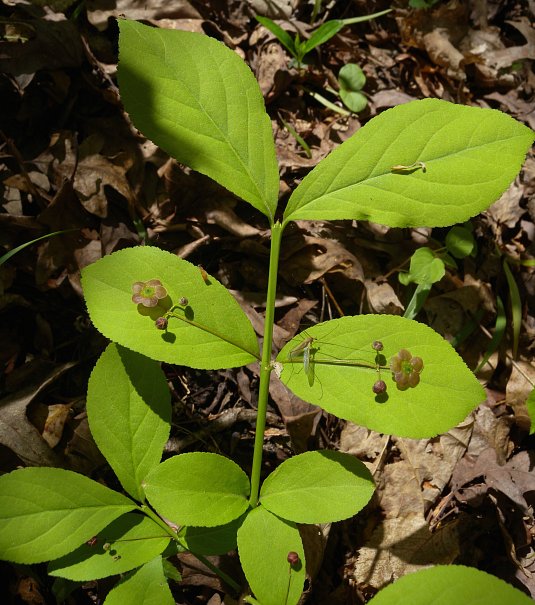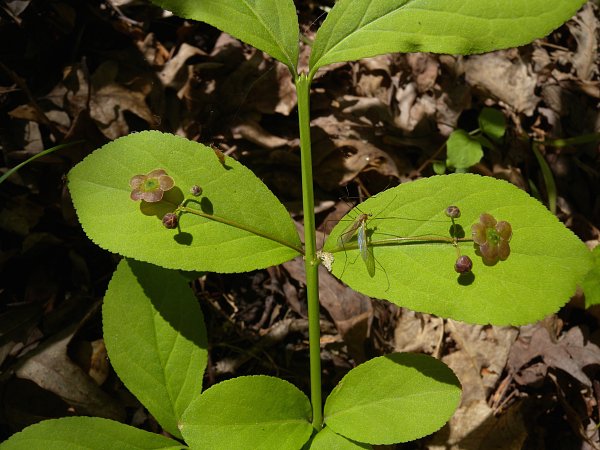Description: This perennial plant is ½–1½' tall and up to 3½' long, developing as a dwarf shrub or a short woody vine. The central stem is either ascending or sprawling, branching occasionally. The central stem and any lateral stems are light green or purple, terete or angular, and hairless. Pairs of opposite leaves occur at interval along these stems. Individual leaves are up to 2½" long and 1¾" across, obovate, hairless, and finely serrate-crenate along their margins. The upper surface of each leaf is medium green, while the lower surface is slightly more pale with raised pinnate veins. The petioles are about 1/8" (3 mm.) long. Cymes of 1-4 flowers occasionally develop from the axils of the leaves. The peduncle of each cyme is about 1-2" long, while the pedicels of individual flowers are much shorter. Individual flowers are up to 1/3" (8 mm.) across, consisting of 5 pale greenish purple petals, a short green calyx with 5 lobes, 5 short stamens, and a central pistil. The petals are nearly orbicular in shape and slightly overlapping.

The blooming
period occurs from mid-spring to early summer and lasts about 1½
months. Each fertile flower is replaced by a tuberculate globoid fruit
about ¾" across. This fruit usually has 3 lobed cells (less often,
there are 5). The outer surface of the fruit is orange or pink. When it
splits open along its lobes, the fleshy arils covering the seeds are
revealed; they are scarlet. New rootlets can develop where the stems
have contact with the ground; as a result, this plant can reproduce
vegetatively.
Cultivation:
The preference is partial sun to medium shade, moist to slightly dry
conditions, and soil that is loamy or rocky. Well-drained areas are
preferred. Because of its habitat of growth, Running Strawberry Bush
can be used as a ground cover.

Range &
Habitat:
Running Strawberry Bush is an uncommon plant that is found only in NE
Illinois, east-central Illinois, and southern Illinois (see Distribution
Map), where it is native. Illinois lies along the NW edge of
its range. Habitats
include upland rocky woodlands, wooded slopes, thinly wooded bluffs,
and shaded to semi-shaded areas along the edges of cliffs. Running
Strawberry is a conservative species that is found in high quality
habitats.
Faunal Associations:
Information about floral-faunal relationships for this particular
species is limited. The nectar and pollen of the flowers probably
attract small bees and miscellaneous flies. Some insects that are known
to feed on Euonymus spp. include Taedia
evonymi (Euonymus Plant Bug), Otiorhynchus sulcatus
(Black Vine Weevil), Unaspis euonymi (Euonymus
Scale), caterpillars of Herpetogramma thestealis
(Pyralid Moth sp.), caterpillars of Yponomeuta multipunctella
(American Ermine Moth), and the larvae of Stenocorus
cinnamopterus (Long-Horned Beetle sp.). The larvae of this
latter insect bore through branches. The fruit of Running Strawberry
Bush is probably eaten by the Wild Turkey and other birds, while the
foliage is occasionally eaten by White-Tailed Deer and Cottontail
Rabbits, even though both the fruit and foliage are supposed to be
somewhat toxic.

Photographic
Location:
Along the wooded slope of a bluff in Vermilion County, Illinois.
Comments:
This interesting shrub should be cultivated more often. Running
Strawberry Bush differs from other Euonymus spp. by
its low habit of growth (less than 2' tall) and stems that often sprawl
across the ground (less than 4' long). Other Euonymus spp.
are either taller or they have longer stems. The flowers of Running
Strawberry Bush have 5 petals, while the flowers of most Eurasian Euonymus
spp. in Illinois have only 4 petals. This low shrub can be
confused with a small Euonymus americanus
(Strawberry Bush). Running Strawberry Bush usually has obovate leaves
that are widest above the middle, while the latter shrub has leaves
that are widest at or below the middle. A mature specimen of Strawberry
Bush is about 3-6' tall.